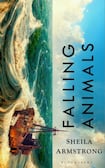
Set in a fictional town on the northwest coast of Ireland, Sheila Armstrong’s Falling Animals revolves around an unexplained death. The body of an unknown man is found on a beach, “neatly seated, almost polite, as if it didn’t want to make a fuss”; there are no signs of foul play. A second narrative strand, obscurely connected to this mystery, concerns a Russian container ship that had foundered off the same coast some years earlier, its wreckage subsequently destroyed in a fire. We meet a number of characters whose lives have been touched by these events. They include the pathologist investigating the death, a Philippine sailor who had worked aboard the ship, a diver sent to examine the wreckage, an artist who produces a painting of the blaze, a Polish woman claiming to be the dead man’s wife and a local policeman who wonders if the body is some kind of sinister harbinger — “just the first of another plague”.
Several of these people are in emotional turmoil. Lila, a former galley cook on the doomed vessel, is grieving for her teenage daughter, who died in a road traffic accident. Mitchell, the young man who happened across the body, had gone to the beach that day with vague thoughts of suicide. Darragh, a bus driver who was the person last to see the man alive, “has always felt he is standing outside his own memories, rather than a living, breathing participant”. These narratives are interspersed with brooding meditations on mankind’s relationship with the sea: we reflect on divers killed by decompression; the economic and ecological vagaries of North Sea fishing; the brutality of the ship-breaking industry; and the atomised, itinerant lives of maritime workers — “the invisible men who haul the global economy on their backs”.
Though the characters’ personal woes have a somewhat boilerplate quality, there is nevertheless a graceful poignancy in Armstrong’s doleful homage to the vicissitudes of seafaring
Falling Animals is Armstrong’s first work of long-form fiction, following hot on the heels of her 2022 short story collection, How to Gut a Fish. The novel’s unusual format — a series of pen portraits, loosely interwoven and coalescing around a theme — is admirably ambitious for a debut. The prose, however, is underwhelming, a blend of corny lyricism — we ponder “the grey, grey sky”; shirts that are “pure, pure white”; and “this vast, vast world” — and dreary idioms: things are “worth their weight in gold”, people are “half a world away”, an area is searched “with a fine-tooth comb”. The descriptive language is florid and occasionally repetitious. A memory arrives “with searing vividness” a mere eight pages after homesickness is described as a “hot searing lack”; the movement of tectonic plates is invoked twice — the first time figuratively, to describe a shift in feeling; the second time, with slightly ludicrous overkill, to describe the “drawn out and forceful” impact of a ship hitting a sandbank.
Similes abound. Some are compellingly weird, such as the description of Mitchell’s suicidal ideation taking shape during a bike ride — a “ribbon of thought … weaving in and out of the spokes of the wheels like a disinterested eel”. Most are dull in a painting-by-numbers way: people in a busy village centre are “buzzing past like sand flies”; a few pages later, on a beach, they are “like little scurrying ants”. There are far too many: I counted upwards of 140, in a book of barely 230 pages. Moreover, some of the metaphorical language doesn’t quite land. When we read that a half-built housing estate “blooms like a horrible fungus on the top of the cliff, the developers long gone bankrupt”, the choice of verb jars: “blooms” seems odd for something that stopped growing ages ago. In such moments it feels as though words and phrases have been chosen primarily for timbre, with insufficient regard for meaning.
READ MORE
It’s a shame because the novel is not without merit. Though the characters’ personal woes have a somewhat boilerplate quality, there is nevertheless a graceful poignancy in Armstrong’s doleful homage to the vicissitudes of seafaring: the mystery of this lonely cadaver becomes a cypher for the unknowability of the world, and the smallness of human endeavours when set against the power and grace of nature. There are some lovely snatches of folk memory, including a vignette about a whale skeleton found in a corner of a field, quite far inland (“the old folk claim it is a wishing chair”). In its lugubrious solemnity and languid pacing, Falling Animals has something of the homily about it, evincing a moral sensibility intelligently attuned to the interconnectedness of our ecological and spiritual malaises. An assertive editorial intervention could perhaps have reined in the author’s baroque impulses, whittled away some of those flourishes, and done greater justice to the novel’s intriguing premise.















